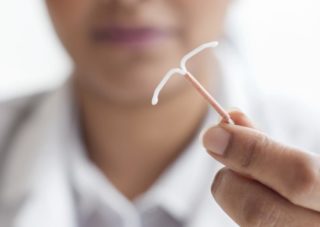Around 922 million women (and their partners) are currently using birth control. In the United States, the number sits at around 46 million, with a large number choosing the pill as their choice of contraceptive.
Other forms of hormonal birth control include:
- The patch: Placed on one’s back, bottom, or arm and changed weekly for 3 weeks, taking the fourth week off.
- The ring: Worn inside the vagina, releasing hormones to prevent ovulation. The person leaves the ring in for 3 weeks and then takes it out for 1 week.
- Birth control shot: The shot is administered every 12 weeks in a doctor’s office and it suppresses ovulation.
- Intrauterine devices (IUDs): IUDs are inserted into the uterus by a doctor, and they release hormones that prevent ovulation. They need to be changed every 3 to 10 years, depending on the type.
- Implant: The implant is placed under the skin on the inside of the upper arm by a doctor and it lasts for up to three years.
Now while birth control pills are both convenient as well as effective when it comes to preventing unwanted pregnancies, the contraceptive is not without controversy. In fact, there are a number of health risks that have been associated with its use.
Types of Birth Control Pills
Birth control pills can be categorized as either combined pills or progestin-only pills. 
Combined birth control pill
These pills contain more than one type of female hormone and the chemical hormones used to mimic the effects of the female hormones estrogen and progestin. The pills not only stop ovulation, but they also thicken cervical mucus which then prevents sperm from reaching the uterus.
Progestin-only birth control pill (“minipills”)
As the name suggests, these pills are free of estrogen, and they only contain progestin. They’re regularly used by women who can’t take estrogen for health reasons.
Progestin-only pills prevent unwanted pregnancies by thickening the cervical mucus and by thinning the uterus lining. In doing so, they make it harder for an egg to implant in the uterus, thus preventing pregnancy.
What else is the pill used for?
Now, while the majority of women take the pill in order to avoid falling pregnant, birth control pills can also be used to address other health concerns. These include:
- Regulating menstrual cycles
- Easing period pains
- Combating acne (1)
- Managing endometriosis
5 Health risks from birth control pills
Unfortunately, the continuously raised estrogen levels in our bodies due to the use of birth control pills can increase the risks of serious health concerns.
1. Nutrient Deficiency
Unfortunately, the pill can deplete nutrients such as folate, vitamin B2, B6, B12, vitamin C and E, magnesium, selenium, and zinc. Nutrient deficiency is often at the forefront of the development of a number of chronic diseases.
2. Yeast Infections
There are a lot of factors that can increase the risk for, as well as worsening, yeast infections and one of these things is birth control pills.
One study published in the European Journal of Obstetrics & Gynecology and Reproductive Biology found a close relationship between contraceptive use and yeast infections. It appears that hormonal changes as a result of the pill can increase the risk of a yeast infection.
3. Depression and anxiety
Any woman who’s ever experienced PMS symptoms understands how fluctuating hormones can trigger mood swings. That said, it should come as no surprise to find out that the hormonal changes that come with the use of hormonal contraceptives can also affect one’s mood.
For instance, a study published in JAMA Psychiatry found a significant increase in depression rates among women taking birth control as compared to women who were not.
Additionally, a 2018 study published in the American Journal of Psychiatry found that young women who used hormonal contraceptives faced three-times the risk of suicide compared to women who had never used hormonal birth control.
So what could be the reason for this?
Well, a more recent study presented at the annual meeting of the Radiological Society of North America (RSNA) suggested that women taking the pill had significantly smaller hypothalamus volume, compared to women not taking the pill, and this change was strongly linked to increased anger and depressive symptoms.
4. Cancer
The National Cancer Institute suggested that long-term use of the pill can greatly increase a woman’s risk of cervical cancer (2). That said, a separate study also found that the risk of cervical cancer declines over time after women stop using oral contraceptives.
In regards to breast cancer, which is the most common cancer in women worldwide, one study found that hormonal contraceptives can increase the risk of breast cancer. However, the risk is also dependent on additional factors such as age and family history.
Moreover, it’s not all bad news when it comes to birth control and cancer.
A large-scale study published in JAMA Oncology found that long-term use of birth control can help to reduce the risk of both ovarian and endometrial cancer. A separate 2017 study found that long-term use of the pill did the same for the risk of colorectal cancer.
It’s important to reach out to your doctor if you’re worried about your risk of cancer. After all, early detection saves lives.
5. Blood Clots
A blood clot can increase a person’s risk of stroke and heart attack, and it appears that combined birth control pills increase people’s risk of developing a blood clot (3).
Furthermore, a separate study found that the use of the pill increases the risk of ischemic stroke (strokes triggered by blood clots). However, it should be noted that this risk is very small among women who do not have other stroke risk factors.
10 Non-Hormonal Birth Control Options
Now with the aforementioned health concerns, you may be on the lookout for alternative options. Thankfully, there are a few non-hormonal options that you can look at.
1. Condoms
Probably the most popular form of birth control, condoms are widely and easily accessible, and they’re sometimes even free. What’s more, condoms are the only form of birth control that can protect against STIs and STDs.
Male condoms are placed over the penis and female condoms are a pouch with a ring at each end that is inserted into the vagina and both serve to prevent sperm from entering the female’s body.
In terms of effectiveness, male condoms are about 82% effective (this rate takes poor application as well as breakage or slippage during intercourse into consideration). Female condoms are at least 79% effective with typical use.
Male condoms are commonly made from latex, however, if you have an allergy, alternative materials include polyurethane or lambskin. Female condoms are mostly made from polyurethane or nitrile.
2. Spermicide
Spermicide is a chemical that comes in the form of cream, foam, or gel. It’s placed inside the vagina before sex as it helps to kill sperm.
Unfortunately, spermicide has a failure rate of 28%, however, this rate is much lower when it’s used along with condoms as well as other forms of non-hormonal contraceptives.
Additionally, some women may experience skin irritation or an allergic reaction when using spermicide. Also, all spermicides sold in the United States contain nonoxynol-9 and this compound may affect the skin as well as around the genital area, making one more likely to contract HIV (4). It’s important to immediately reach out to your doctor if you have any concerns.
3. Diaphragms
This is a small, flexible cup made of silicone that is inserted, by a doctor, into the vagina, covering the cervix. Diaphragms work best when used with spermicide and they have a 92-96% success rate at preventing pregnancy.
They are reusable and can be used for up to 2 years. However, they should never be used during a menstrual cycle.
The cervical cap is similar to a diaphragm except that it’s much smaller. It’s also best used with spermicide, and it has a 71% effectiveness rate.
4. Copper IUD
The non-hormonal IUD is a T-shaped device that contains copper. It’s placed into the uterus by the doctor and the copper in the IUD filters into the uterus, making the environment inhospitable for sperm.
It can last for up to 10 years and has a 99% effective rate when it comes to preventing pregnancy. That said, the side effects of copper IUDs include irregular menstrual cycles as well as heavier and more painful periods.
5. The sponge
This is a sponge that’s made out of plastic foam and that contains spermicide.
Almost like a tampon, a woman would insert a sponge into her vagina before sexual intercourse and remove it by pulling on the accompanying nylon loop. It helps to prevent pregnancy by covering the cervix as well as by releasing spermicide.
The Association of Reproductive Health Professionals found that the sponge is more effective in women who are not yet pregnant. In women who have never been pregnant, the failure rate 12% with regular use, compared to the 24% rate in women who have been pregnant before.
While you can leave the sponge in for up to 24 hours, it’s important to never leave it in for more than 30 hours in total. Each sponge can only be used once and you should throw it in the trash after removal.
That said, risk factors associated with the sponge include yeast infections and toxic shock syndrome.
6. The Calendar Method
As the name suggests, this form of natural birth control focuses on abstaining from sex during the week in which a woman is ovulating.
This technique works best if a woman’s menstrual cycle is very regular as well as accurately timed. This method is also more effective when used with the temperature and mucus methods described below.
7. The Temperature Method
Ovulation can cause a change in a woman’s temperature therefore, this method involves measuring a woman’s temperature every morning, to better recognize her fertility pattern. It’s important to abstain from sex during this period of high fertility.
As factors like illness or lack of sleep can affect one’s temperature, the temperature method has a 75 % effectiveness rate.
Image by rawpixel.com
8. The Mucus Method
This method involves tracking your vaginal discharge.
The first few days after your period, there is often no discharge, however, as estrogen levels begin to rise, you will notice a cloudy, tacky mucus. As ovulation nears, you will then notice an increase in volume, as well as the discharge, becoming clearer and stringy. Once ovulation passes, the discharge will return to the tacky, cloudy mucus.
This method works best for women with regular cycles.
9. Withdrawal
Often referred to as the pull-out method, this form of birth control occurs when the penis is removed from the vagina before ejaculation. According to Planned Parenthood, for every 100 people who use the pull-out method perfectly, 4 will get pregnant.
10. Sterilization
Sterilization provides a more permanent form of birth control as the procedure is quite difficult to reverse.
In men, surgeons will block or cut the tubes that transport sperm from the testicles to the penis, and in women, they will block the fallopian tubes.
The bottom line
Deciding on a birth control method is a personal choice and one should do their research before selecting a method that is effective, safe, and convenient.
Want to know more?
Coming off the pill isn’t always easy and some common side-effects include hormonal acne. That said, there are ways to avoid acne breakouts when going off the pill.
References
InformedHealth.org [Internet]. Cologne, Germany: Institute for Quality and Efficiency in Health Care (IQWiG); 2006-. Which birth control pills can help reduce acne? 2013 Jan 16 [Updated 2019 Sep 26]. Available from: https://www.ncbi.nlm.nih.gov/books/NBK279209/
Iversen, L., Sivasubramaniam, S., Lee, A. J., Fielding, S., & Hannaford, P. C. (2017). American journal of obstetrics and gynecology, 216(6), 580.e1–580.e9. https://doi.org/10.1016/j.ajog.2017.02.002
Michels, K. A., Pfeiffer, R. M., Brinton, L. A., & Trabert, B. (2018). JAMA oncology, 4(4), 516–521. https://doi.org/10.1001/jamaoncol.2017.4942
Murphy, N., Xu, L., Zervoudakis, A., Xue, X., Kabat, G., Rohan, T. E., Wassertheil-Smoller, S., O’Sullivan, M. J., Thomson, C., Messina, C., Strickler, H. D., & Gunter, M. J. (2017). British journal of cancer, 116(1), 117–125. https://doi.org/10.1038/bjc.2016.345
Nachtigall, L., Naftolin, F., Keefe, . (2018). The New England journal of medicine. 378. 1265. 10.1056/NEJMc1800054.
Skovlund CW, Mørch LS, Kessing LV, Lidegaard Ø. (2016). JAMA Psychiatry. 73(11):1154–1162. doi:10.1001/jamapsychiatry.2016.2387
Skovlund, C. W., Mørch, L. S., Kessing, L. V., Lange, T., & Lidegaard, Ø. (2018). The American journal of psychiatry, 175(4), 336–342. https://doi.org/10.1176/appi.ajp.2017.17060616








